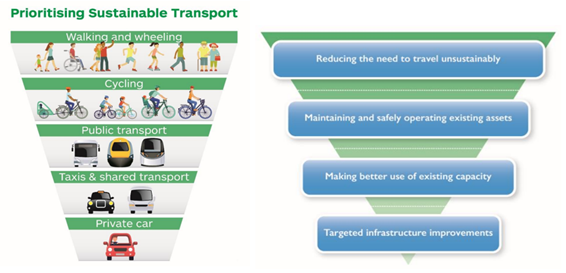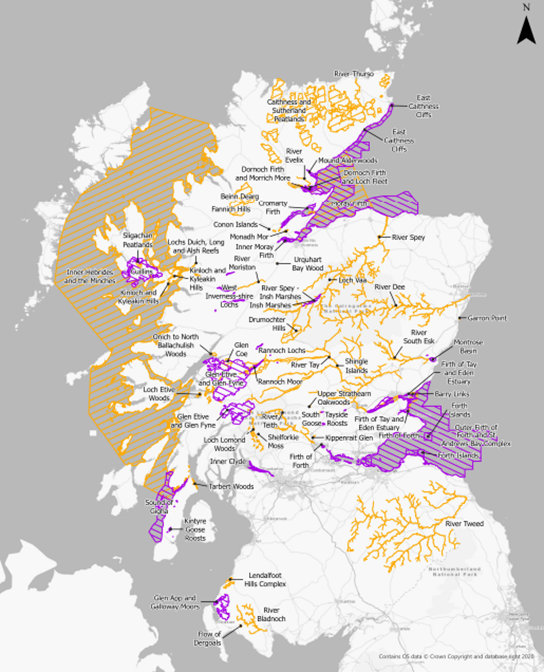About Transport Scotland
Transport Scotland is the national transport agency for Scotland. The agency is responsible for delivering a safe, efficient, cost-effective and sustainable transport system for the benefit of the people of Scotland. Our work is underpinned by a corporate plan that reflects the National Transport Strategy 2020 (NTS2) which was published on 5 February 2020.
National Transport Strategy 2
The NTS2 is for the whole transport system, people and freight, and considers why we travel and how those trips are made, by including walking, wheelchair use, cycling, and motorised transport - travelling by bus, train, ferry, car, lorry and aeroplane. It is a strategy for all users: those travelling to, from and within Scotland.
The NTS2 sets out the strategic framework for a 20-year period (2020 - 2040), within which future decisions on investment will be made. It sets out a Vision for our transport system, which is underpinned by four priorities, namely:
- Reduces inequalities;
- Takes climate action;
- Helps deliver inclusive economic growth; and
- Improves our health and wellbeing.
Each of these priorities represent the ingredients required for a sustainable transport network and none more so than the commitment to take responsible action to tackle climate change. The inextricable link with Biodiversity loss, outlined above, means that there is even more emphasis on the need to mitigate and adapt to the impacts Climate Change. The following two priorities are particularly relevant to our approach to biodiversity:
- Takes climate action:
This priority focuses on mitigation, adaption and delivering Net-Zero targets whilst making cleaner, greener choices.
- Improves our health and wellbeing:
This priority focuses on creating better, safer and more sustainable communities.
To achieve the priorities set out in NTS2, decision making is further underpinned by the Sustainable Travel Hierarchy which promotes walking, wheeling, cycling, public transport and shared transport options in preference to single occupancy private car use for the movement of people.
In addition, the Sustainable Investment Hierarchy is used to inform investment decisions and ensure transport options that reduce the need to travel unsustainably are prioritised over options that require constructing new infrastructure. The Sustainable Hierarchies are presented in Figure 7, below, and illustrate the order of supported travel mode from walking and wheeling at the top, through public transport options and down to the private car. The Sustainable Investment Hierarchy looks to avoid unsustainable travel, make best use of existing assets and capacity before focusing on targeted improvements.
The diagram showing the sustainable travel hierarchy prioritises travel as follows:
- Walking and wheeling
- Cycling
- Public transport
- Taxis and shared Transport
- Private Car.
The diagram showing the travel investment hierarchy prioritises transport options as follows:
- Reducing the need to travel unsustainably
- Maintaining and safely operating existing assets
- Making better use of existing capacity
- Targeted infrastructure improvements.

National Transport Strategy Delivery Plans
The NTS2 does not identify and present specific projects, schemes, initiatives or interventions. Therefore, the Agency produces Delivery Plans that set out the actions we will take to support delivery of the NTS2 and provide a transport system that is sustainable, inclusive, safe and accessible.
The first National Transport Strategy 2 Delivery Plan covers the initial two years of the NTS2 (2020 – 2022) and presents the broad actions taken forward by the Scottish Government and its agencies (including Transport Scotland) to deliver on its vision and priorities up to end-March of 2022, taking account of the impact of COVID-19 and global climate emergency.
Of particular relevance to the preservation and restoration of biodiversity are actions that contribute towards the NTS2 priority of “taking climate action”. The Delivery Plan includes a breadth of actions taken forward the agency that are applicable to this priority.
The strategic policies that these actions address are the following:
- Reduce emissions generated by the transport system to mitigate climate change and improve air quality;
- Support management of demand to encourage more sustainable transport choices;
- Facilitate a shift to more sustainable and space-efficient modes of transport for people and goods;
- Ensure the transport system adapts to the projected climate change impacts; and
- Improve the quality and availability of information to enable all to make more sustainable transport choices.
As part of the green recovery, the actions set out in the Delivery Plan seek to support people to make active travel choices, for instance, making permanent, where appropriate, some of the active travel infrastructure introduced during the COVID-19 outbreak.
The second NTS2 Delivery Plan covers the period 2022 to 2023 and builds on the previously announced measures on transport and headline areas of work from across Government.
As part of this Delivery Plan, actions towards delivering a green, sustainable and active transport system encompass the following:
- Supporting the transition from car use to active travel;
- Transforming bus travel, primarily by decarbonising our bus fleet and implementing bus priority measures;
- Enabling the transition to electric vehicles; and
- Investing in innovation to increase the uptake and availability of low carbon and more efficient technologies and approaches.
Strategic Transport Projects Review 2
The Strategic Transport Projects Review 2 (STPR2) published in January 2022 is the second Scotland-wide review of the strategic transport network seeking to deliver the vision, priorities and outcomes of the NTS2.
This review of the strategic transport network’s performance will inform transport investment in Scotland for a 20-year period between 2022 and 2042, by providing evidence-based recommendations on which Scottish Ministers can base future transport investment decisions.
The STPR2 considers the transport needs of Scotland’s people and communities, and examines active travel (walking, wheeling, cycling), bus, ferry, rail and motorways and trunk roads as well as passenger and freight access to major ports and airports. These needs are reviewed from national and regional perspectives to reflect their different geographies, travel patterns and demands.
The STPR2 process follows Scottish Transport Appraisal Guidance (STAG), an established evidence-based approach to identify problems and opportunities, set transport objectives to address these and generate, sift and appraise options for changes to the transport system. In STPR2, the STAG process led to 45 recommendations grouped around six key themes, namely improving active travel infrastructure; influencing travel choices and behaviour; enhancing access to affordable public transport; decarbonising transport; and increasing safety and resilience on the strategic transport network.
Furthermore, as part of STPR2, Habitats Regulations Appraisal (HRA) was carried out to determine any likely significant effects on European Union-designated ‘European sites’. These sites include Special Areas of Conservation (SACs) designated under the Habitats Directive (92/43/EEC) and Special Protection Areas (SPAs) designated under the Birds Directive (2009/147/EEC).
As such, each stage in the development of the STPR2 was reviewed to determine any potential indirect or direct likely significant effects on the integrity of sites designated due to the presence of specific habitats and species of internationally important biodiversity value, otherwise known as ‘qualifying interest features’.
Each STPR2 recommendation was appraised against certain categories of potential impact, namely direct loss of habitat; loss of functionally-linked habitat; waterborne pollution; airborne pollution; hydrological changes; disturbance of qualifying species; barriers and/or displacement; injury or mortality; changes to predator-prey dynamics; spread of invasive non-native species. The HRA concluded that no likely significant effects were identified due to the intentionally high-level of detail in the 45 STPR2 recommendations. This provides the opportunity to design schemes to avoid or adequately mitigate effects on European sites in Scotland.

Corporate Delivery Plan
The Transport Scotland Corporate Plan 2020 - 2021 published in January 2021 sought to introduce a one-year update to our 2017-20 Corporate Plan.
For 2020-21, the Agency set out actions to be delivered, whilst keeping a clear focus on our vision as set out in the NTS2. We will play our part in setting up a future that enables sustainable, inclusive, economic growth with a focus on protecting our climate.
Environmental Sustainability is a crucial and integral aspect of Transport Scotland’s activities, and over this Corporate Plan period there has been a significant emphasis on air quality and climate change, as shown in the following objectives set out in the Corporate Plan:
- We will support decarbonisation, including establishing a Zero Emission heavy duty vehicle programme and invest in a zero drivetrain testing facility in 2021.
- Our goal is to improve air quality and protect public health, we have restarted work to introduce Low Emissions Zones across our four largest cities by early 2022.
- We will expand the Low Carbon Transport Loan scheme, to support Scottish households and business in purchasing ultra-low emission vehicles, to include used electric vehicles, removing more upfront costs for people, and increasing the accessibility of the scheme for lower income households.
- We will continue our programme of trunk road improvements and maintenance projects, strengthening our overall network resilience.
The following sections relate primarily to the management of the Trunk Road Network, its maintenance and development.
The response relating to Scotland’s rail network is included in a separate, interlinked document prepared by Network Rail entitled Scotland's Railway Biodiversity Duty Report 2021-23.